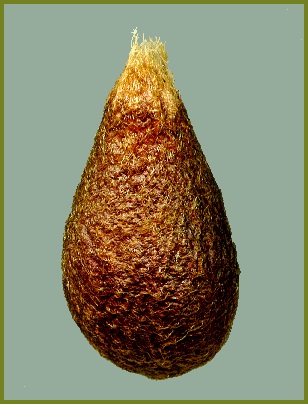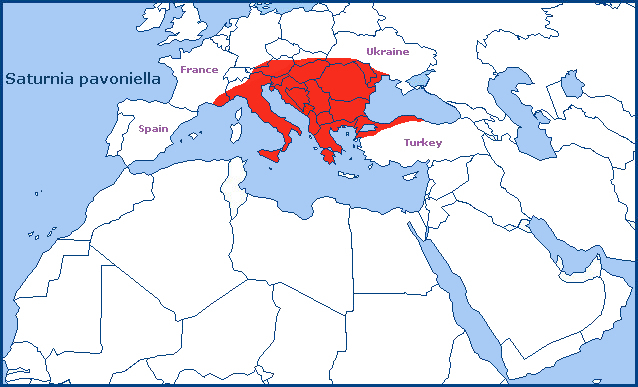UK: Ligurian Emperor Moth, F: Paon de nuit austral, D: Südliches Kleines Nachtpfauenauge; Ligurisches Nachtpfauenauge, CZ: Martináč podobný, I: Piccolo pavone.
Phalaena pavoniella Scopoli, 1763, Entomologia Carniolica: 192, fig. 483.Type locality: [Slovenia].
(Taxonomic note. This species was separated from Saturnia pavonia by Huemer & Nässig (2003) for several reasons, particularly because of F1 hybrid infertility (of females and of most males) between the two, consistent differences in wing markings and differences in genitalial morphology. These differences have been documented in detail by Jost et al. (2000)).
(Taxonomic note. An in-depth analysis of the relationship between this species and Saturnia pavonia by Khan at al. (2024) has confirmed them to be separate but related species. Their analyses indicates that although past introgressions have taken place there is no evidence to suggest an ongoing admixture between the two, demonstrating that the taxa have reached full postzygotic reproductive isolation and hence represent two distinct biological species.)
[Further details on this species, as well as photos of all stages, can be found on Lepiforum.]
Holarctic; western Palaearctic region. Pleistocene refuge: Monocentric -- Pontomediterranean refuge.
Wingspan (males) 45--70mm, (females) 50--95mm.


Larger, yellower and paler than Saturnia pavonia pavonia.
As per Saturnia pavonia pavonia, but with one major difference; females of Saturnia pavoniella generally pair several times, those of Saturnia pavonia pavonia only call and pair once (Huemer & Nässig, 2003). In both species the males are diurnal.

Late February to June; in northern Greece mainly in May.
OVUM: Oval, 1.4 x 2.2mm, greyish-white with olive-brown gum. Laid in an untidy mass mixed with abdominal scales, hatching ten to fourteen days later.
LARVA: Full-fed 67--88mm.
The newly-hatched, 2--3mm-long larvae consume part of their eggshells before clustering together. At this stage they are black and bristly. As they grow, patches of orange appear around the base of the tubercles, particularly ventro-laterally. These spread and coalesce with further growth, and gradually become green. Most full-grown larva are peppermint-green with a yellow sub-spiracular line on the abdominal segments. Each segment bears dorsally a half-ring of six yellow, spine-topped tubercles. These may have a black ring around their base which, in some individuals, link up to form black patches. Full-grown larvae of this species have far less black pigmentation than is found in Saturnia pavonia pavonia.
Young larvae cluster together and move about quite openly, generally feeding on low vegeation. However, as from the third instar they disperse and eventually become solitary. Larger larvae tend to be found higher up on shrubs.



Hostplants. Polyphagous, with different plants being preferred in different areas. Favourites are species of bramble/raspberry (Rubus), Prunus (P. spinosa), hawthorn (Crataegus), oak (Quercus), hornbeam (Carpinus), birch (Betula), willow (Salix), heath (Erica), blueberry (Vaccinium), spiraea (Spiraea), meadowsweet (Filipendula), purple loosetrife (Lythrum), cinquefoil (Potentilla), wild rose (Rosa), heather (Calluna), sea buckthorn (Hippophae) etc. It has even been found on Robinia pseudoacacia.
In northern Greece the preferred hosts are Rubus ulmifolius and Pyrus amygdaliformis.
PUPA: 22--28mm. Light to dark brown, noticeably dorso-ventrally flattened, and 'comma'-shaped. Formed in a coarse, thin-walled, pear-shaped, double, unsealed brown cocoon low down amongst the hostplant, often at ground-level.

Tachinidae: Exorista grandis (Zetterstedt, 1844), Masicera pavoniae (Robineau-Desvoidy, 1830).
From the alpine regions of Germany, Austria, Italy (including Sicily (Parenzan & Porcelli, 2006), and Salento in southern Italy (Durante & Pellegrino, 2019)) and Czechia down across southeastern Europe to Bulgaria (Hristova & Beshkov, 2016) and northwestern Turkey; however, the status and distribution of this species in Asia Minor is uncertain (Nässig, 1981), although it has been recorded from the Black Sea coast at Shile, northeast of Istanbul (Baron, 2008). The population in southeastern France appears to a mixture of this species and Saturnia pavonia pavonia (Khan at al., 2024). They also confirmed that Saturnia pavoniella does not occur in Spain.
In Italy, Austria and Germany this species overlaps with Saturnia pavonia pavonia to a small degree, producing a limited hybrid/suture zone (Khan at al., 2024).
Extra-limital range. None.

None.
 Return to species list
Return to species list